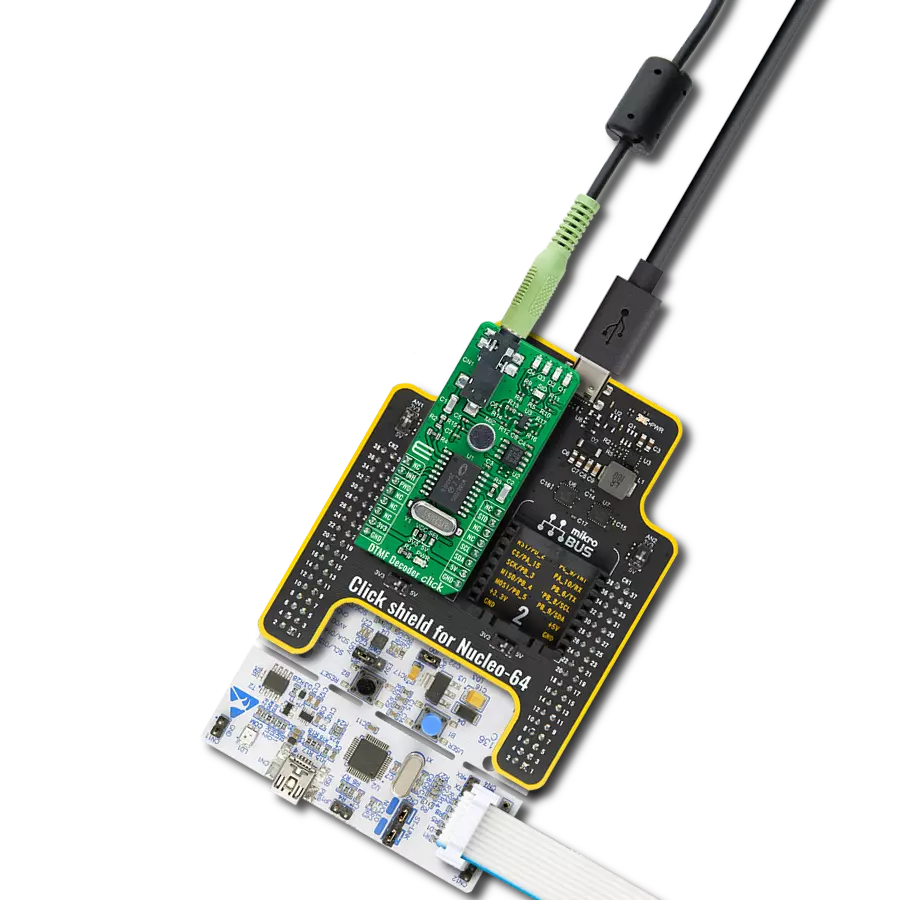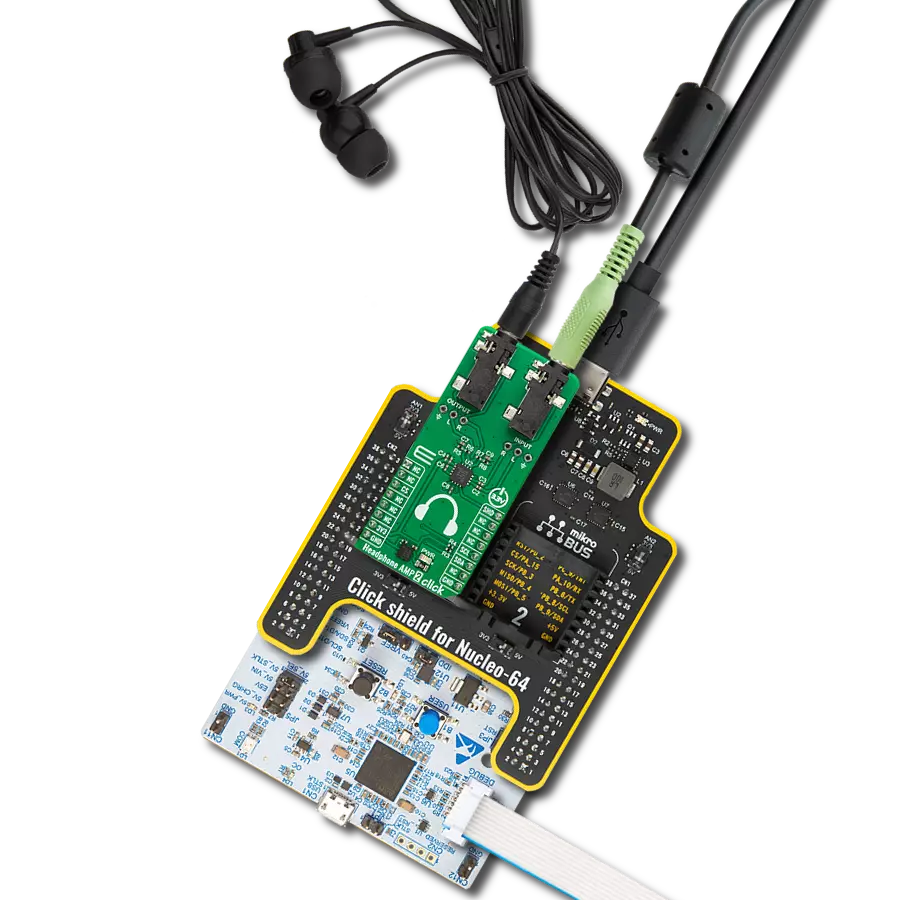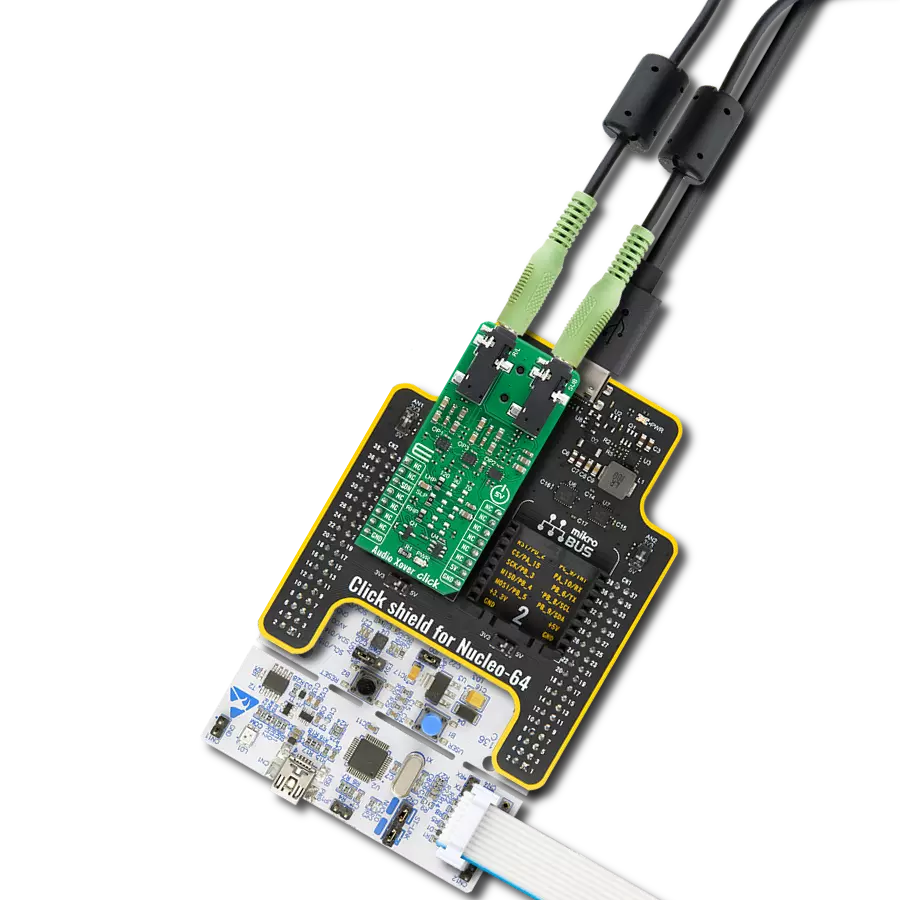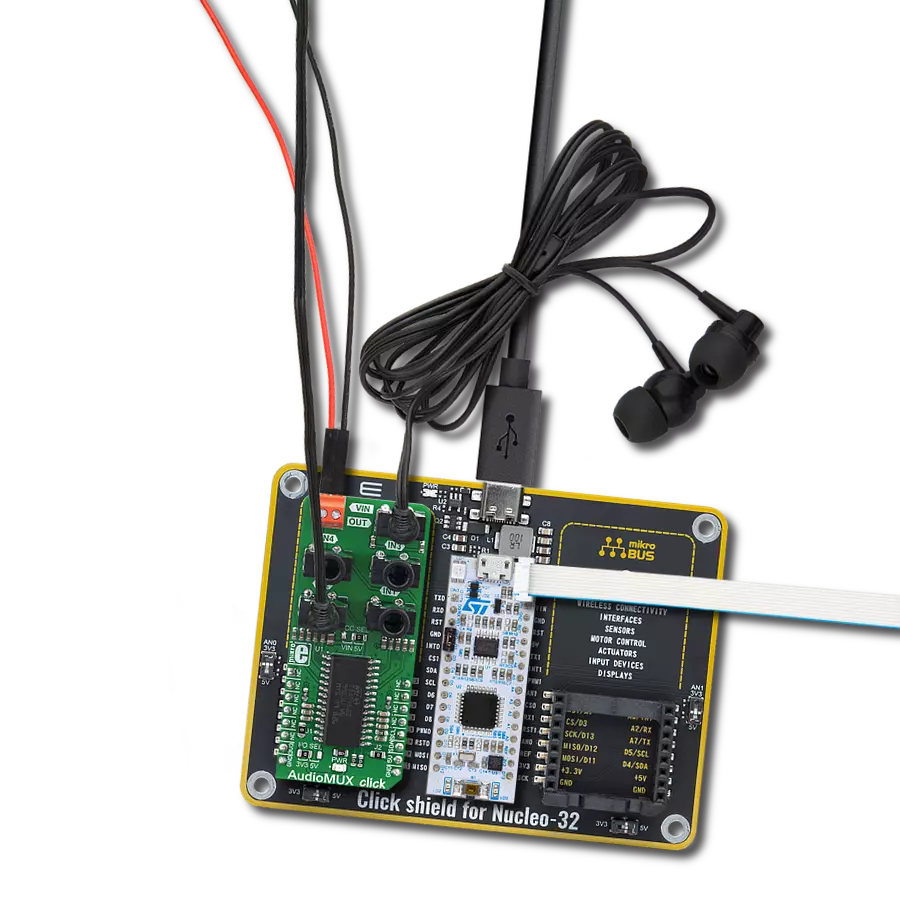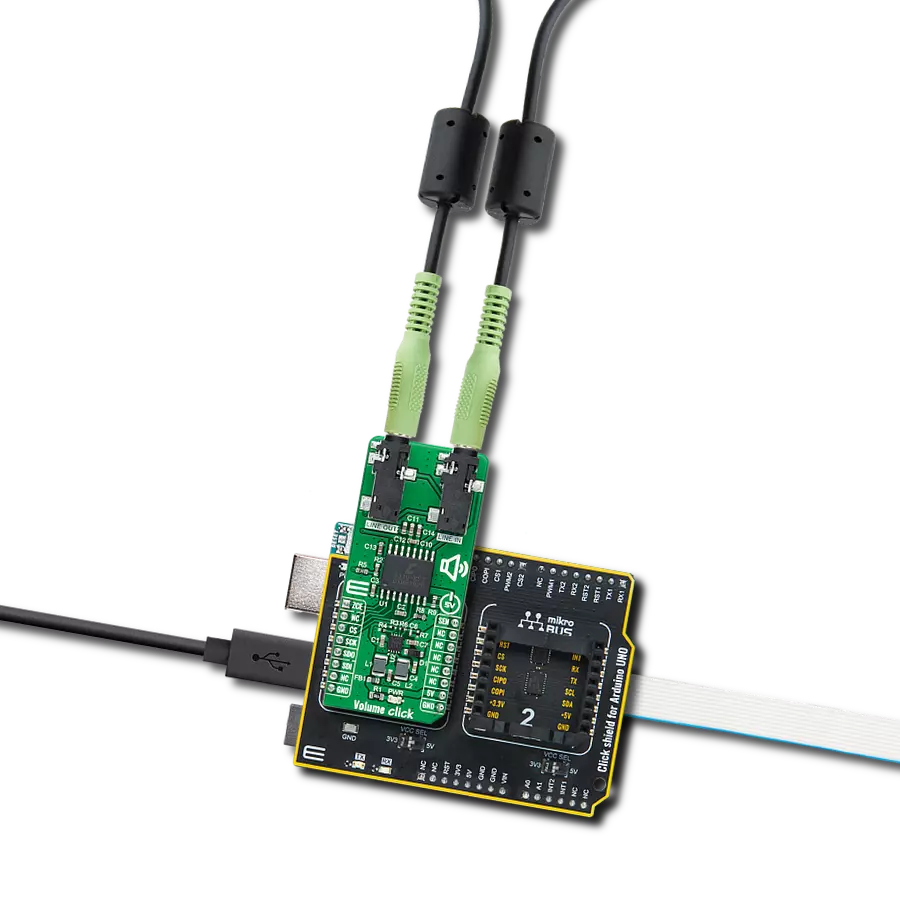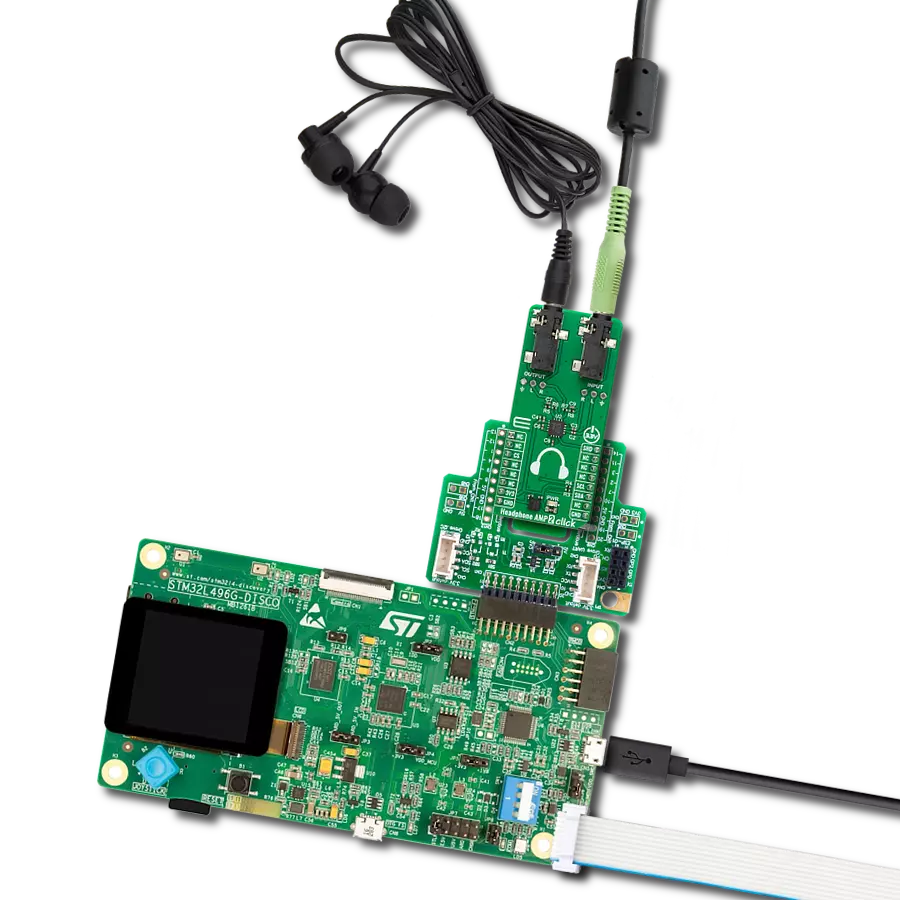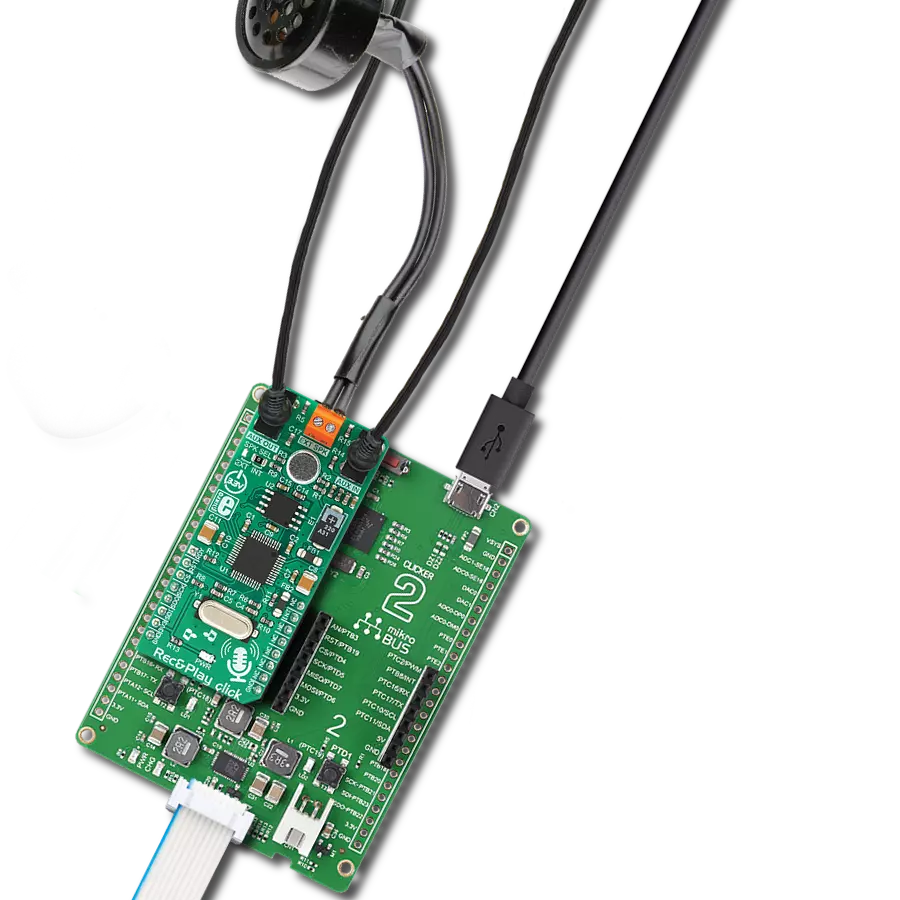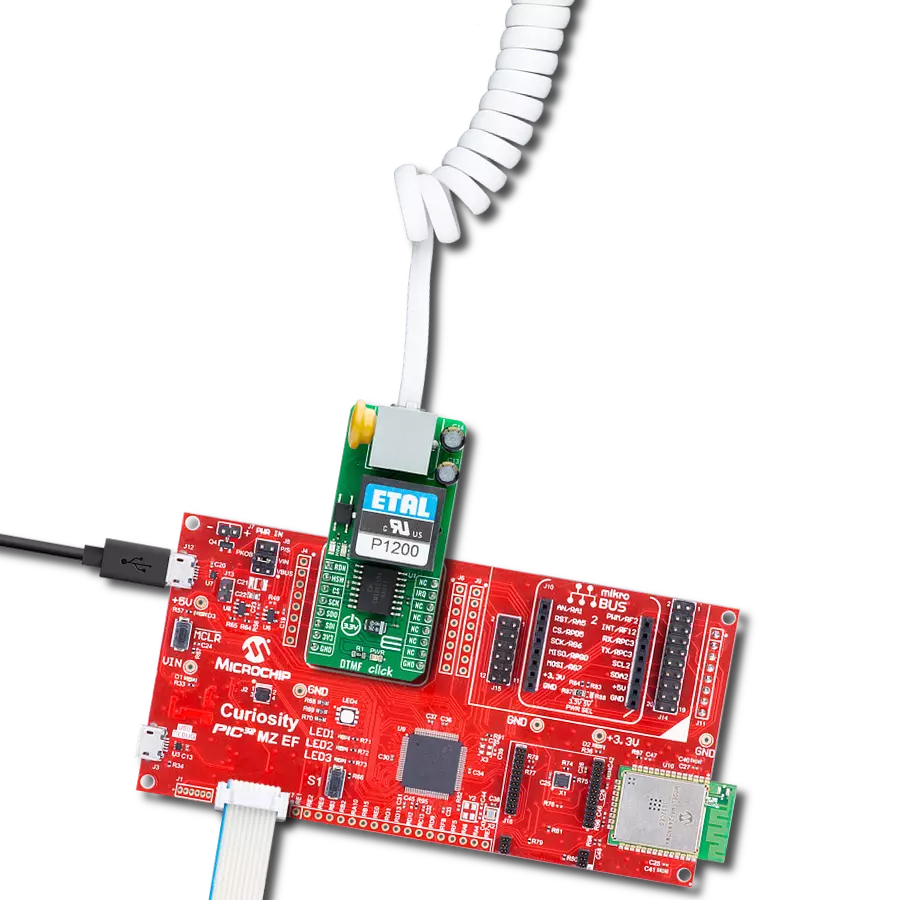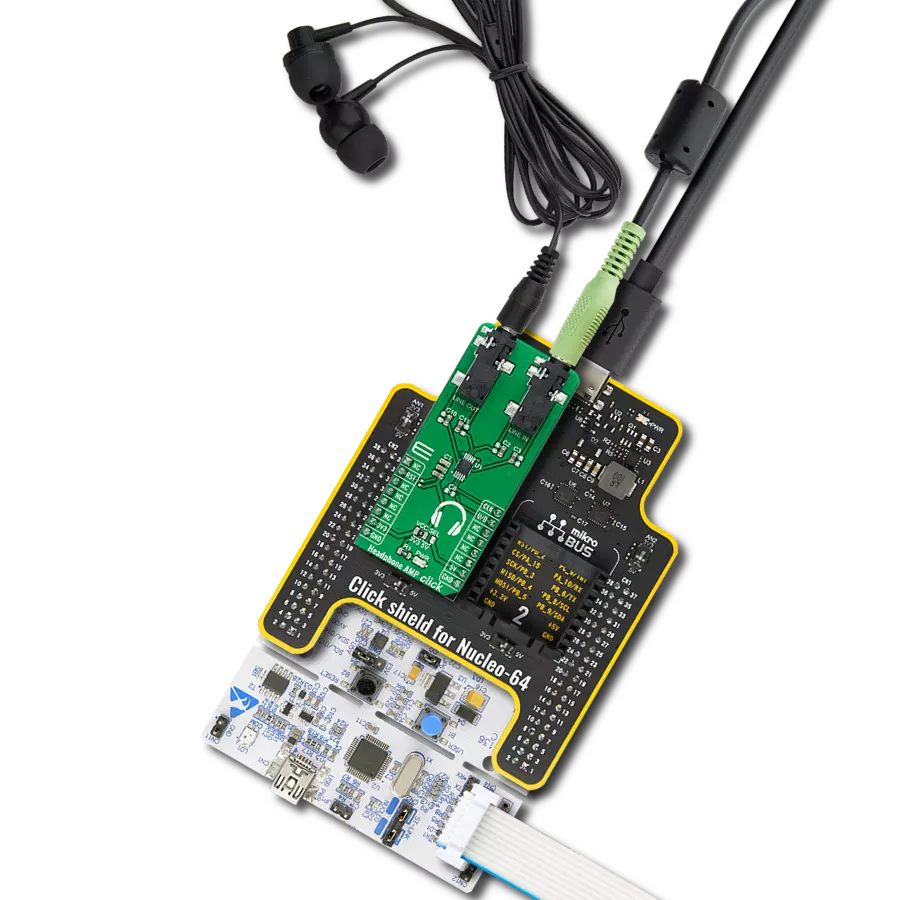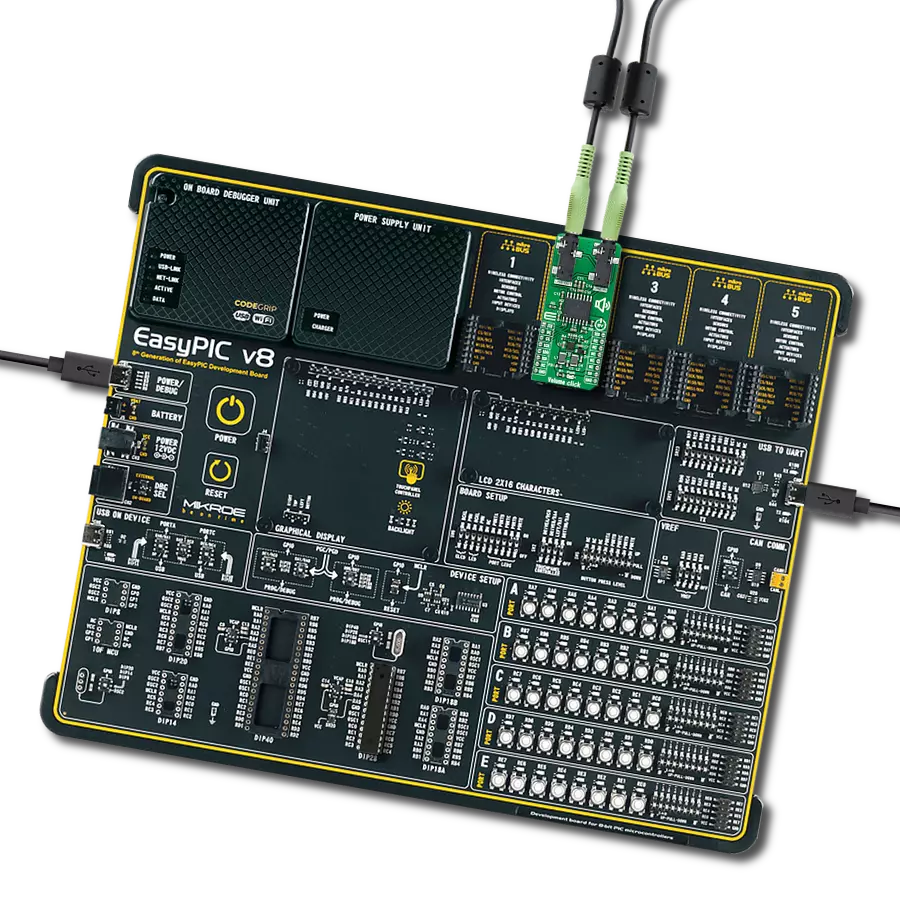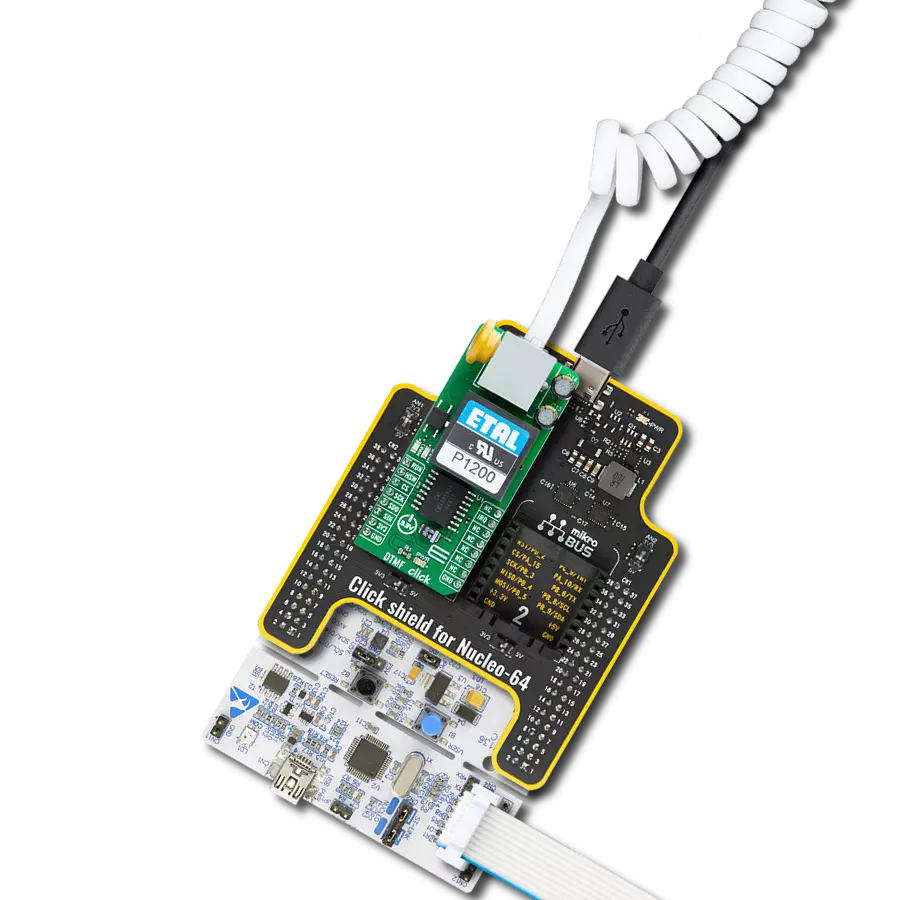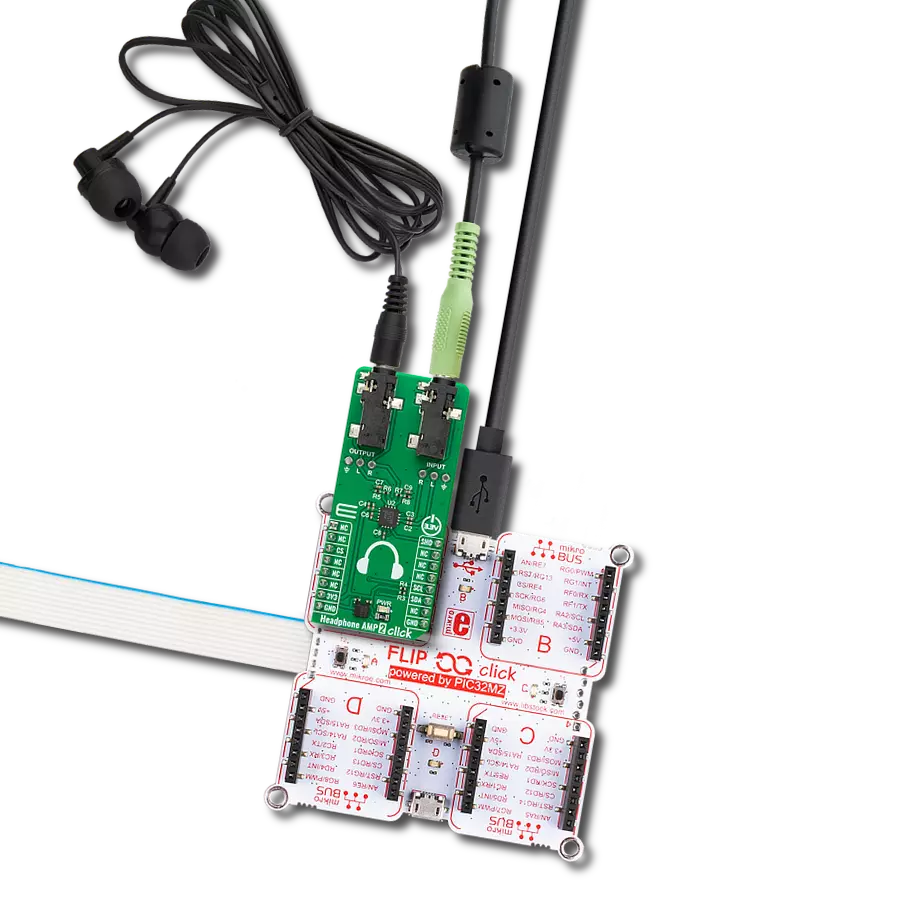Explore the cutting-edge DTMF receiver that seamlessly combines band-split filtering and digital decoding, enabling the detection and decoding of all 16 DTMF tone-pairs into a 4-bit code
A
A
Hardware Overview
How does it work?
DTMF Decoder Click is based on the MT8870D, an integrated DTMF receiver with enhanced sensitivity from Microchip Technology. It offers low power consumption and high performance. It consists of a band split filter section separating the high and low group tones, followed by a digital counting section that verifies the received tones' frequency and duration before passing the corresponding code to the output bus. This Click board™ has two ways to detect tones: a mobile phone with a 3.5mm jack, which provides the DTMF signals to the MT8870D decoder, or an onboard microphone to listen to the DTMF tones generated by the cell phone. The MT8870D uses digital counting techniques to detect and decode all 16 DTMF tone-pairs into a 4-bit code. DTMF
Decoder Click communicates with MCU using a standard I2C 2-Wire interface, with a clock frequency up to 100kHz in the Standard and 400kHz in the Fast Mode. Using the PCA9536 port expander that communicates with the MCU via I2C communication, it is possible to display visually, in binary form, the digit of the pressed number. The digit in binary form is then visually displayed using four red LEDs, labeled from Q1 to Q4, in the board's upper right corner. This Click board™ also has a power-down feature routed on the CS pin of the mikroBUS™ socket labeled as PWD. A logic high applied to pin PWD will power down the device to minimize the power consumption in a Standby mode, which stops the oscillator and the filters' functions. Also, it uses the
interrupt pin of the mikroBUS™ labeled as STD with an additional LED indicator signaling that a received tone pair has been registered, and the INH pin, which inhibits the detection of tones representing characters A, B, C, and D. The output code will remain the same as the previously detected code. This Click board™ can operate with either 3.3V or 5V logic voltage levels selected via the VCC SEL jumper. This way, both 3.3V and 5V capable MCUs can use the communication lines properly. Also, this Click board™ comes equipped with a library containing easy-to-use functions and an example code that can be used as a reference for further development.
Features overview
Development board
Nucleo-64 with STM32F091RC MCU offers a cost-effective and adaptable platform for developers to explore new ideas and prototype their designs. This board harnesses the versatility of the STM32 microcontroller, enabling users to select the optimal balance of performance and power consumption for their projects. It accommodates the STM32 microcontroller in the LQFP64 package and includes essential components such as a user LED, which doubles as an ARDUINO® signal, alongside user and reset push-buttons, and a 32.768kHz crystal oscillator for precise timing operations. Designed with expansion and flexibility in mind, the Nucleo-64 board features an ARDUINO® Uno V3 expansion connector and ST morpho extension pin
headers, granting complete access to the STM32's I/Os for comprehensive project integration. Power supply options are adaptable, supporting ST-LINK USB VBUS or external power sources, ensuring adaptability in various development environments. The board also has an on-board ST-LINK debugger/programmer with USB re-enumeration capability, simplifying the programming and debugging process. Moreover, the board is designed to simplify advanced development with its external SMPS for efficient Vcore logic supply, support for USB Device full speed or USB SNK/UFP full speed, and built-in cryptographic features, enhancing both the power efficiency and security of projects. Additional connectivity is
provided through dedicated connectors for external SMPS experimentation, a USB connector for the ST-LINK, and a MIPI® debug connector, expanding the possibilities for hardware interfacing and experimentation. Developers will find extensive support through comprehensive free software libraries and examples, courtesy of the STM32Cube MCU Package. This, combined with compatibility with a wide array of Integrated Development Environments (IDEs), including IAR Embedded Workbench®, MDK-ARM, and STM32CubeIDE, ensures a smooth and efficient development experience, allowing users to fully leverage the capabilities of the Nucleo-64 board in their projects.
Microcontroller Overview
MCU Card / MCU

Architecture
ARM Cortex-M0
MCU Memory (KB)
256
Silicon Vendor
STMicroelectronics
Pin count
64
RAM (Bytes)
32768
You complete me!
Accessories
Click Shield for Nucleo-64 comes equipped with two proprietary mikroBUS™ sockets, allowing all the Click board™ devices to be interfaced with the STM32 Nucleo-64 board with no effort. This way, Mikroe allows its users to add any functionality from our ever-growing range of Click boards™, such as WiFi, GSM, GPS, Bluetooth, ZigBee, environmental sensors, LEDs, speech recognition, motor control, movement sensors, and many more. More than 1537 Click boards™, which can be stacked and integrated, are at your disposal. The STM32 Nucleo-64 boards are based on the microcontrollers in 64-pin packages, a 32-bit MCU with an ARM Cortex M4 processor operating at 84MHz, 512Kb Flash, and 96KB SRAM, divided into two regions where the top section represents the ST-Link/V2 debugger and programmer while the bottom section of the board is an actual development board. These boards are controlled and powered conveniently through a USB connection to program and efficiently debug the Nucleo-64 board out of the box, with an additional USB cable connected to the USB mini port on the board. Most of the STM32 microcontroller pins are brought to the IO pins on the left and right edge of the board, which are then connected to two existing mikroBUS™ sockets. This Click Shield also has several switches that perform functions such as selecting the logic levels of analog signals on mikroBUS™ sockets and selecting logic voltage levels of the mikroBUS™ sockets themselves. Besides, the user is offered the possibility of using any Click board™ with the help of existing bidirectional level-shifting voltage translators, regardless of whether the Click board™ operates at a 3.3V or 5V logic voltage level. Once you connect the STM32 Nucleo-64 board with our Click Shield for Nucleo-64, you can access hundreds of Click boards™, working with 3.3V or 5V logic voltage levels.
Used MCU Pins
mikroBUS™ mapper
Take a closer look
Click board™ Schematic

Step by step
Project assembly
Software Support
Library Description
This library contains API for DTMF Decoder Click driver.
Key functions:
dtmfdecoder_tone_read- This function reads a last registered tone and returns decoded data in character formatdtmfdecoder_delayed_steering_check- This function checks the state of the StD pindtmfdecoder_powerdown_off- This function powers up the device and along with the oscillator
Open Source
Code example
The complete application code and a ready-to-use project are available through the NECTO Studio Package Manager for direct installation in the NECTO Studio. The application code can also be found on the MIKROE GitHub account.
/*!
* @file main.c
* @brief DTMFDecoder Click example
*
* # Description
* This example shows the basic tone capture of
* DTMF frequencies, decoding and representing
* them on the UART LOG.
*
* The demo application is composed of two sections :
*
* ## Application Init
* Initializes I2C and UART LOG drivers and powers
* on the device.
*
* ## Application Task
* Checks the delayed steering for incoming tones
* and decoding them on the UART LOG. Holding the
* same key will recognize multiple tone generation,
* the tone register delay constant can be set to
* adjust the tolerance.
*
* @author Stefan Nikolic
*
*/
#include "board.h"
#include "log.h"
#include "dtmfdecoder.h"
static dtmfdecoder_t dtmfdecoder;
static log_t logger;
static const uint16_t tone_register_delay = 200;
void application_init ( void ) {
log_cfg_t log_cfg; /**< Logger config object. */
dtmfdecoder_cfg_t dtmfdecoder_cfg; /**< Click config object. */
/**
* Logger initialization.
* Default baud rate: 115200
* Default log level: LOG_LEVEL_DEBUG
* @note If USB_UART_RX and USB_UART_TX
* are defined as HAL_PIN_NC, you will
* need to define them manually for log to work.
* See @b LOG_MAP_USB_UART macro definition for detailed explanation.
*/
LOG_MAP_USB_UART( log_cfg );
log_init( &logger, &log_cfg );
log_info( &logger, " Application Init " );
// Click initialization.
dtmfdecoder_cfg_setup( &dtmfdecoder_cfg );
DTMFDECODER_MAP_MIKROBUS( dtmfdecoder_cfg, MIKROBUS_1 );
err_t init_flag = dtmfdecoder_init( &dtmfdecoder, &dtmfdecoder_cfg );
if ( init_flag == I2C_MASTER_ERROR ) {
log_error( &logger, " Application Init Error. " );
log_info( &logger, " Please, run program again... " );
for ( ; ; );
}
dtmfdecoder_default_cfg ( &dtmfdecoder );
Delay_ms ( 100 );
log_info( &logger, " Application Task " );
}
void application_task ( void ) {
uint8_t result;
if ( dtmfdecoder_delayed_steering_check( &dtmfdecoder ) ) {
result = dtmfdecoder_tone_read( &dtmfdecoder );
log_printf( &logger, " Detected key tone:\t%c\r\n", result );
Delay_ms ( tone_register_delay );
}
}
int main ( void )
{
/* Do not remove this line or clock might not be set correctly. */
#ifdef PREINIT_SUPPORTED
preinit();
#endif
application_init( );
for ( ; ; )
{
application_task( );
}
return 0;
}
// ------------------------------------------------------------------------ END
Additional Support
Resources
Category:Signal Processing
